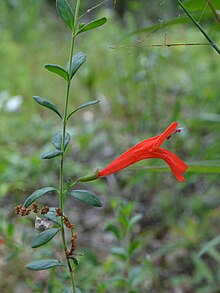| Clinopodium coccineum | |
|---|---|

| |
| Scientific classification | |
| Kingdom: | Plantae |
| Clade: | Tracheophytes |
| Clade: | Angiosperms |
| Clade: | Eudicots |
| Clade: | Asterids |
| Order: | Lamiales |
| Family: | Lamiaceae |
| Genus: | Clinopodium |
| Species: | C. coccineum |
| Binomial name | |
| Clinopodium coccineum (Nutt. ex Hook.) Kuntze | |
| Synonyms | |
| |
Clinopodium coccineum, commonly known as scarlet calamint or red basil, is a evergreen perennial plant of the family Lamiaceae.
It is indigenous to the coastal areas of south-eastern United States and is found in Alabama, Florida, Georgia, and Mississippi. C. coccineum is a woody perennial, which grows to a height of 12–35 in (30–90 cm). It produces reddish-orange tubular labiate flowers. It has simple obovate leaves, with dentate margins. The leaves have a glandular (downy) surface and are opposite.
References
- "Lady Bird Johnson Wildflower Center – The University of Texas at Austin". www.wildflower.org.
- "Calamintha coccinea – Species Details". Atlas of Florida Plants.
- "USDA Plants Database".
- Sciences, College of (June 7, 2017). "Scarlet Calamint (Calamintha coccinea)".
- "Hortipedia – Clinopodium coccineum".
- "Hortus Camdenensis | Calamintha coccinea (Nutt. ex Hook.) Benth". hortuscamden.com.
| Taxon identifiers | |
|---|---|
| Clinopodium coccineum |
|
| Cunila coccinea | |